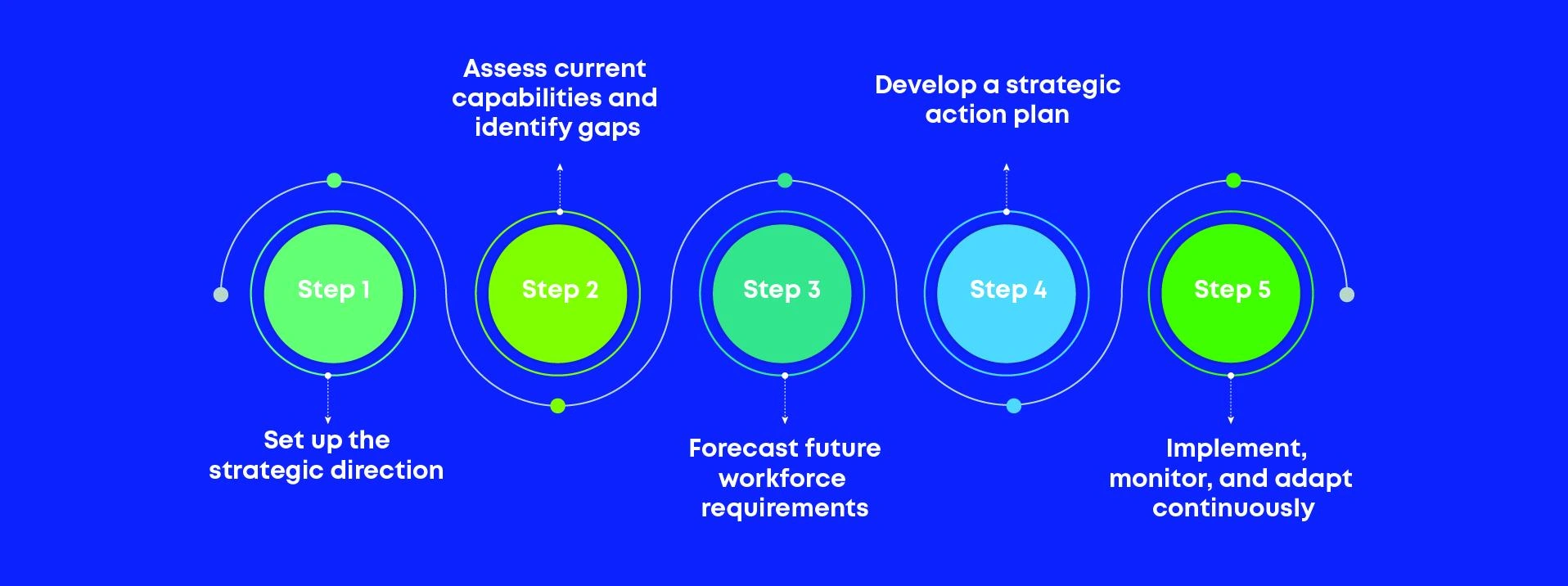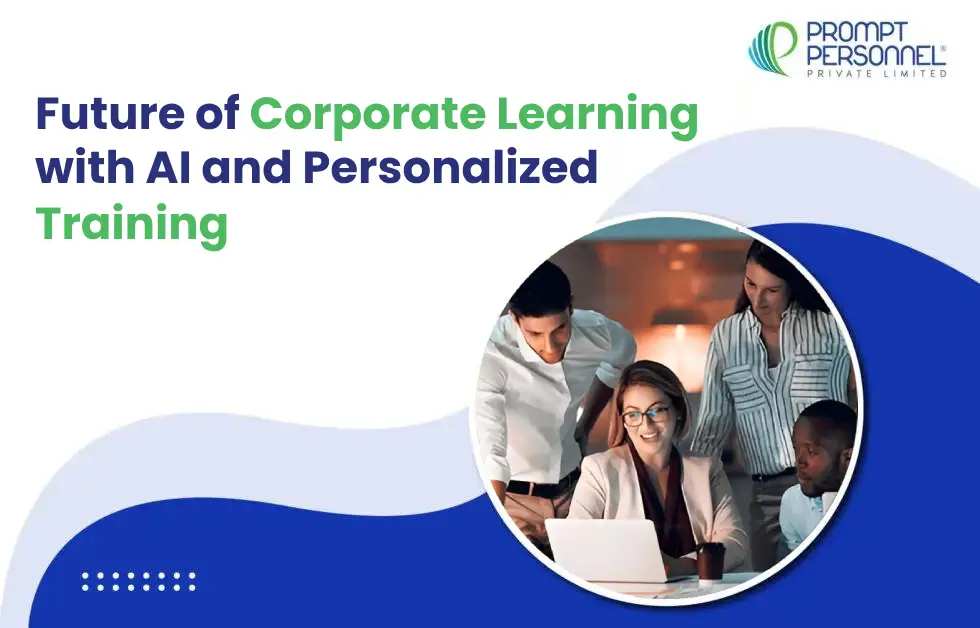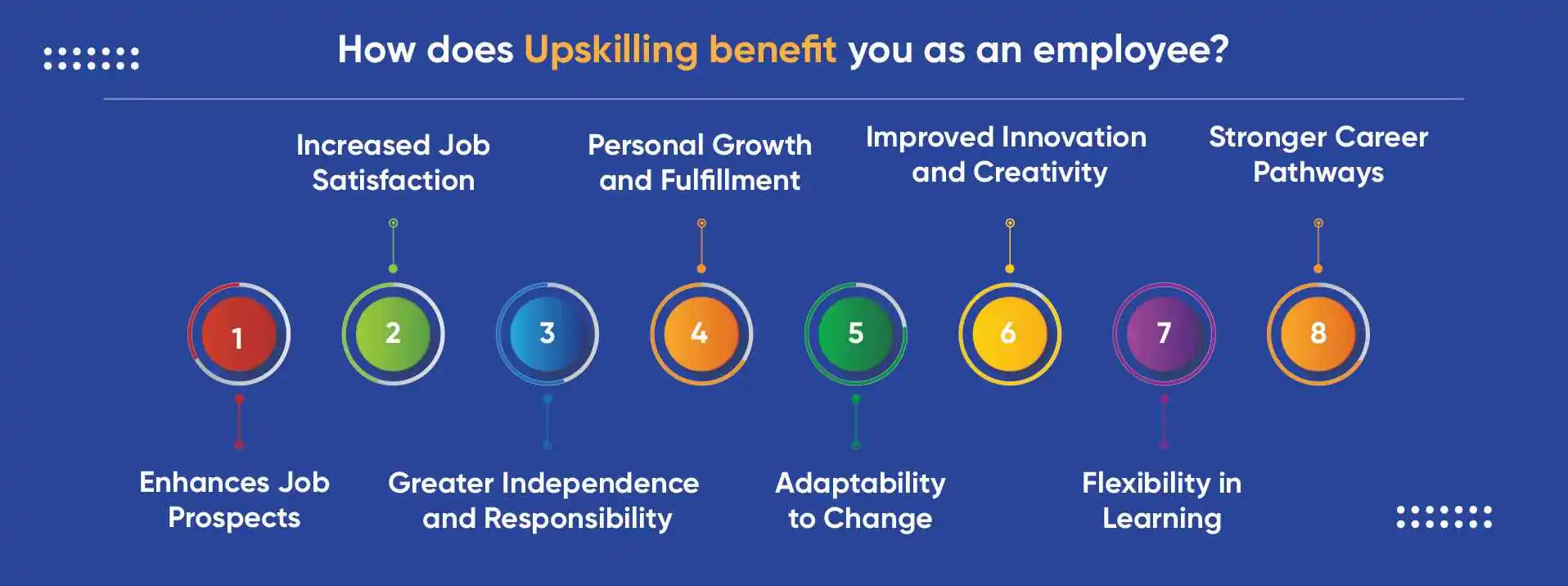
CHRO Guide: Strategic Workforce Planning FY 2025-26
Are you trying to match your employees with future business objectives as a CHRO (Chief Human Resource Officer? Strategic workforce planning (SWP) for organizations may then be of interest to you. You will play a crucial part in this process as we move closer to FY 2025–2026 by making sure that companies have the proper people in place to achieve their strategic goals.
In this blog, you will explore key elements of strategic workforce planning and CHRO priorities of 2025, practical advice on improving their strategic workforce management strategy. You’ll also explore the importance of utilizing data analytics to make sound decisions, allowing you to make decisions that maximize resource allocation, retention initiatives, and much more.
What is Strategic Workforce Planning?
To ensure that you have the right people with the right capabilities in the right roles at the right time, this step focuses on planning and forecasting your workforce supply and demand. The overarching goal of this process is to fit workforce capacity within corporate strategic intent.
Why Strategic Workforce Planning is Essential for CHROs in 2025-26
First, let’s look at the workforce scenario. We are aware that managing and organizing your personnel presents many difficulties. Among the difficulties you might face are:
Gaps in Skills – The technology has advanced so fast that it would be no surprise that more than half of the workforce lacks the skills to stay ahead of the curve. This has given rise to upskilling and reskilling as a critical part of workforce management.
Retention Issues – Yeah, correct. Employee expectations have changed over the years. In 2025, they value workplace culture, flexibility, and growth opportunities more than anything. And this has made retaining ace employees even more difficult.
Hybrid Workforces – It is no wonder that the ongoing popularity of remote and hybrid work arrangements necessitates you to balance flexibility and productivity with employee engagement.
Below are the reasons why SWP is crucial for CHROs.
- Disruptions in the Workforce
Studies say that by 2025, approximately 44% of workers’ skills will be disrupted due to technological changes and a shift in job demands. You would have to proactively cater to these changes and disruptions, maybe through upskilling or reskilling initiatives. This is a good solution to keep the workforce abreast of the latest advancements.
- Aligning the Workforce with Business Strategy
With the support of strategic workforce planning, now you can translate your business goals into realizable talent plans so that even in the coming times, your company will possess the right abilities that fulfill its needs.
- Successful Cooperation among C-Suite
Cooperation amongst you, CFOs, and CIOs is required in order to align the SWP and implement it. Such cross-functional planning guarantees a smooth execution of workforce priorities.
- Improving the Employee Experience
It’s 2025, and employees are placing more value on the company’s work environment, career advancement opportunities, physical and mental well-being, than on compensation. To attract the best talent and retain them, you must make efforts to optimize your employee engagement and collaboration.
As a CHRO, you can transform alignment by converting workforce plans into business goals. You must ensure that the workforce plans are connected to wider strategic and financial goals through collaboration with other C-suite executives, such as CFOs and CIOs. Predictive AI platforms and data insights enable you to make effective allocations of resources. In strategic HR planning you should keep the proper talent available to capture future demands at the expense of no resources. Aligning the workforce may assist the business in holding onto a competitive advantage by acting before time with changes in the marketplace and with innovativeness.

In the coming years, strategic workforce planning will become critical for you to meet short-term challenges and position your organization for long-term success in this fast-changing business environment.
Key Workforce Planning Trends Every CHRO Should Understand
As a CHRO, you can’t miss these key trends that would shape the future of workforce management. Let’s explore workforce planning trends in 2025:
AI in workforce planning
It is not surprising that AI is replacing the majority of manual work in the HR profession. It is also transforming strategic workforce planning. AI-driven predictive analytics can spot talent deficiencies, predict turnover, and even alert you to your future labor requirements. To make effective decisions, you must focus on achieving peak utilization of these tools and incorporating them into your strategic workforce planning cycle.
Skills-based workforce planning
Over the past few years, you may have seen a significant trend away from traditional recruitment towards skill-based hiring. Because technology is developing so quickly, the skills needed for the majority of jobs are changing quickly as well. Performing periodic skills gap analyses, providing upskilling or reskilling training, and developing personalized career development plans for your staff are the main priorities.
Remote and hybrid workforce management
The trend persists. Remote and hybrid work arrangements are still changing the workplace. You need to create ways of balancing flexibility and productivity, ensuring employee engagement within different teams, and setting remote work policies that can retain and attract the best talent.
Multi-generational workforce management
With approximately up to 5 different generations working side by side, you need to create inclusive strategies that can cater to these diverse generations’ needs and expectations.
Increased reliance on gig and flexible workforce
The gig economy is growing at a rapid rate. With more people seeking flexible labor options and cost-effectiveness, the gig workforce, including temporary workers, freelancers, and contractors, is on the rise. Besides managing regulatory, onboarding, and benefits issues, as a CHRO, you might be pondering how to rapidly integrate gig workers into your organization. You can utilize a flexible staffing agency for that.
Emphasis on employee development
Do you want to know the magic of retaining employees and getting them ready for tomorrow? It’s investing in your employees. You, as a CHRO, should have a customized career development plan for your employees. Perhaps you can even utilize software to organize the career development for every single employee and set goals, track progress, and help them upskill.
Sustainability and diversity-focused hiring practices
Employees of today, particularly Gen Zers, prefer to work for organizations that share their values. They choose the organization they wish to collaborate with based on these commonalities. Organizations have begun integrating ethical and sustainable practices into their onboarding procedures to draw in these value-driven workers. Corporate Social Responsibility is now a part of the organization’s long-term success.
Integrating AI & Analytics in Strategic Workforce Planning
Use of analytics and AI in strategic workforce planning is changing the way that companies are managing people and bridging human capital with business aims. Here is a comprehensive view of how AI is changing the game in terms of strategic workforce planning and analytics.
- Scenario Modeling: AI models can forecast future recruitment needs. Machine learning models different future scenarios, enabling businesses to forecast future challenges and opportunities. Scenario modeling is very time-consuming and costly, though.
- Real-time Decision Making: The AI model produces real-time information to enable CHROs like you to make well-informed hiring, training, and resource-allocation decisions. For instance, Walmart uses AI to scan in-store data to automate employee schedules, improving customer satisfaction while lowering labor costs.
- Skills Mapping: AI platforms such as IBM’s system generate tailored learning routes for employees based on their present skills and future career goals. AI-driven systems perform skills forecasting and can align employees with internal roles according to their skills, making mobility and retention as well as filling labor gaps possible.
- Automation of Routine Tasks: The time you could have used on manual processes is now saved. You can now concentrate on other strategic projects. IBM employs AI to automate competency evaluations for its entire global workforce.
Step-by-Step Guide to Effective Strategic Workforce Planning
Want to know how to do strategic workforce planning? And what makes it so essential for you? Here is the guide for you that we have broken down into simpler steps that you can follow along.

Step 1: Align the organizational and workforce plan
First, ensure that the business goals are aligned with your strategic workforce plan. Set clear objectives and KPIs (Key Performance Indicators) to measure the success of the plan. It’s not necessary to rush through this stage. You can take your time, but make sure you’re clear of the goals you desire to accomplish.
Step 2: Identify the gaps you need to address
To begin workforce planning for your organization, you must analyze the current workforce strengths and determine any existing turnover or skill gaps that need to be resolved. All these can be accomplished effortlessly using analytics that will enable you to determine all of the strengths and weaknesses of your workforce with the click of a few buttons!
Step 3: Use technology to forecast workforce demands
Make use of the technology to stay ahead of the challenges. Predict your future hiring requirements based on the growth of your business. Incorporate demand planning in your strategic workforce planning framework to determine the number and types of roles needed to achieve strategic goals.
Step 4: Develop a strategic action plan
What is a strategic action plan? The one that includes strategies related to recruitment, training, retention, and succession planning. These are usually focused on filling gaps that you found in the previous stages. You need to ensure that this action plan is time-bound, has enough budget to execute, and defines responsibilities for each person involved.
Step 5: Now execute and monitor it
All the things you added to the action plan, now you need to put them into ACTION, literally. Arrange some recruitment campaigns and training programs occasionally. You need to track the results of these campaigns using the KPIs you defined at the start. Evaluate these outcomes on a regular basis, as it will help you identify areas for improvement.
How CHROs Can Address Talent Retention Challenges in FY 2025-26
The talent shortage has become a high-priority concern for you. In the face of increasing competition for top talent and changing employee expectations, you will have to implement successful talent attraction strategies for 2025 to drive employee engagement and loyalty.
Invest in your employees’ career development
As per LinkedIn, 94% of employees mentioned that they would remain with their organizations for longer if their career growth were to be addressed. You must make sure that formal programs like mentorship, coaching, and online course access that support upskilling are included in your strategic workforce planning map.
Build the experience
Studies show that effective onboarding can increase retention up to 82%. Organized onboarding allows new hires to rapidly adjust and reduces turnover in the initial months. You must create end-to-end onboarding programs that establish clear expectations and integrate new hires into corporate culture.
Leverage people analytics
With people analytics, CHROs can determine trends in employee turnover, forecast attraction risk, and gain a greater understanding of what employees require, so imagine you would be using people analytics to make informed decisions. Feedback surveys may be employed to measure levels of worker satisfaction and areas.
Recognize and reward their contributions
Acknowledging employees’ contributions regularly can enhance their morale of employees and make them loyal to the company. You should ensure that the remunerations and benefits your employees are being provided with are competitive in the industry, considering the worth of employees’ efforts and skills is being valued.
Improve your managerial effectiveness
Train your managers with the appropriate skills to lead and manage their teams positively. Great leadership is a key driver of employee retention, hence, managers should be trained in conflict management, performance management abilities, and emotional intelligence.
Strategic Workforce Planning Examples
Vision without execution is just a hallucination. Just talking about the benefits of strategic workforce planning won’t cut it. Some organizations have effectively put this into action. Here are real-world examples of how leading companies have implemented SWP effectively.
- Pepsi-Co
Pepsi-Co ensured that terminology, scheduling, and execution were all aligned by putting strategic personnel planning into its business planning system. One of the principal enhancements was the capacity for quantifying the talents of the organization, which can result in successful financial performance. Thus, PepsiCo had aligned personnel planning with its financial plans and sales objectives when it launched the new product. They sought to remove ambiguity in their decision-making process through the use of data streams and linking the needs of the local workforce with global solutions. To develop a comprehensive workforce plan that would serve to advance their organizational goals, their HR team collaborated to recruit leaders.
- IBM
IBM’s employee strategy is strongly focused on inclusion and diversity. To bridge skills gaps globally, they looked to AI. To identify any such gaps, its forecast model provided analytics that regularly assessed staff skills with the aid of AI. It provided tailored learning programs that helped individuals achieve their ambitions in upskilling. They have a digital badge that employs open recognition methods to highlight skills that are in high demand. Establishing a platform that would accommodate diversified talent streams was one of the prime undertakings of IBM; their predictive analytics were used successfully to pre-emptively identify talent gaps.
- Bristol-Myers Squibb (BMS)
BMS developed a comprehensive system for strategic labor planning to manage market limitations and industry competitiveness. They adopted the approach of identifying the organization’s core functions and strategic competencies. They had developed an algorithmic tool for Excel that gathered information on the supply and demand for labor. “Build, Buy, or Borrow” was an approach that only managed skill gaps. Risk assessments of the demand and supply gaps were conducted with this tool. It can be used to develop an action plan that will supplement corporate strategy.
- PwC
PwC helped a client who was struggling with disconnected personnel data between teams. Through integrating data sources into one system and applying an SWP decision-making model for talent development and hiring, they made SWP concepts a reality. The integration of strategic workforce planning principles into their teams to manage disconnected data. They created an evidence-based methodology that assisted with hiring decisions. To fill in any gaps in advance, this also generated workforce forecasts for the next five years.
These examples help us understand how strategic workforce planning is used in leading organizations to address any shortcomings related to talent management.
5. Google
For both short-term and long-term employment planning, Google utilizes strategic workforce planning. It is mostly characterized by its advanced use of analytics and forecasting technologies. To cover any shortage of staff, data analytics is applied to determine any gaps in skills within the existing workforce. Google encourages ownership and teamwork that allow workers to be involved in the organization’s objectives by aligning its human capital programs with its organizational objectives.
6. Amazon
Seasonal fluctuations in demand for products are typical for Amazon. Therefore, it focuses on operational effectiveness in its strategic staffing planning to satisfy all of its customers. It utilizes a highly advanced forecasting model to predict when demand will peak seasonally, especially during holidays or festivals. Their staff is optimized by their technology, which helps in the efficient allocation of human resources across the globe. Amazon’s SWP allows the company to maintain operational effectiveness while adapting quickly to market or customer change.
Common Pitfalls CHROs Must Avoid
You are the driving force behind operational workforce planning and execution, but sometimes, some mishaps can happen. And we want to help you avoid it.
Ignoring talent development
Problem: Neglecting to offer development chances to staff could result in disillusionment, demotivation, and high employee turnover.
Solution: You should make upskilling and reskilling programs, mentorship, and career progression plans their top priorities to build a committed and future-fit workforce.
Misalignment Between HR Strategy and Business Goals
Problem: When HR programs are not aligned with organizational goals, they do not yield significant outcomes.
Solution: You need to work with other executives to ensure HR strategies align with overall business objectives and financial objectives.
Poor Communication with the Workforce
Problem: Inconsistent and unclear communication can create disconnections between leadership and employees, causing mistrust and dissatisfaction.
Solution: You have to keep lines of communication open, communicate frequently with employees, and address their concerns appropriately in order to establish trust and accountability.
Unequal Recognition of Success Stories
Problem: Acknowledging only the success stories of leadership and excluding contributions from other employees can generate resentment and demoralize the workforce.
Solution: Celebrate successes throughout all levels of an organization so that every employee will feel valued for what they can contribute.
Failing to Leverage Data Analytics
Problem: Using anecdotal or outdated workforce planning techniques leads to inefficiencies and lost opportunities.
Solution: Use advanced people analytics to inform talent acquisition, retention, and workforce optimization.
Conclusion
As a CHRO, you will experience many changes throughout this financial year. Since strategic workforce planning will become more important than ever, you should start implementing these strategies by using our guide. Utilize predictive analytics! As you can see, many top companies are doing so to match their workforce plans with their corporate objectives to maintain their competitive edge in the ever-changing market. Strategic workforce planning will help you make sure that, despite competition, your company not only survives but also flourishes.
Strategic workforce planning is all about building the future of your organization while taking advantage of technology for even more efficient workforce management. Discover how Prompt Personnel can assist you in creating your tailored workforce strategy.







